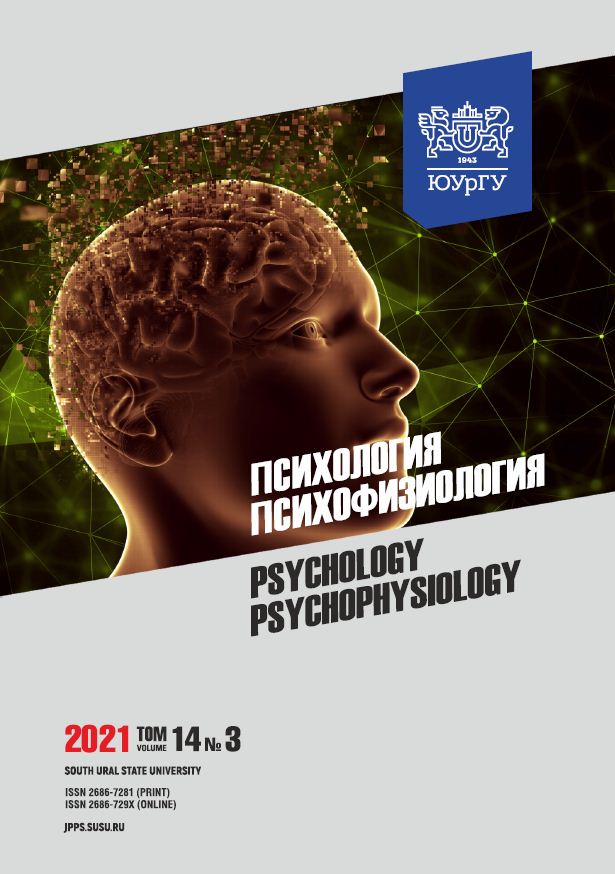DANCE MOVEMENT THERAPY AS A FACTOR IN THE QUALITY OF LIFE AMONG ELDERLY WOMEN
Abstract
Abstract. The relevance of studying the psychological mechanisms of aging is associated with growing life expectancy in different countries, which results in deteriorating health.
The essential factors for maintaining a high quality of life in elderly people are their physical activity and social well-being. Aim. In this regard, the paper aims to investigate the role of dance classes in successful aging due to the maintenance of physical, social, and cognitive activity in elderly women. Materials and methods. A comparative analysis of the quality of life (the SF-36 questionnaire), emotional intelligence and leisure time was performed between the group of women who regularly attended dance classes (experimental group, EG) (n = 30; 59.9 ± 5.5 years) and women who attended lectures of the People's Faculty in the Novosibirsk State Technical University (control group, CG) (n = 30; 61.6 ± 4.2 years). Results. In the absence of significant intergroup differences in the integral self-assessment of the quality of life, EG was characterized by higher values of “general health”, “social functioning” and “mental health” (SF-36 questionnaire) as compared with CG. This effect was accompanied by a preference for active leisure in contrast to CG, which chose different forms of activity in the country house. When analyzing the components of emotional intelligence in EG, higher values of “positive expressiveness” and “empathy for negative emotions” and lower values of “emotion-based decision making” were found in comparison with CG, which may indicate more effective emotional regulation in EG. Conclusion. Thus, dance classes in elderly women can be considered as movement therapy and activation of cognitive potential. In EG, dance movement therapy contributed to a higher assessment of general health, social functioning, and mental health compared with a relatively passive control group.
Downloads
References
2. Heckhausen J., Schulz R. A life span theory of control. Psychological Review. 1995; 102 (2): 284–304. DOI: 10.1037/0033-295x.102.2.284.
3. Simonton D.K. Origins of genius: Darwinian perspectives on creativity. N.Y. Oxford University Press. 1999: 320. https://psycnet.apa.org/record/1999-02789-000
4. Koch S., Kunz T., Lykou S., Cruz R. Effects of dance movement therapy and dance on health-related psychological outcomes: a meta-analysis. Arts Psychother. 2014; 41 (1): 46–64. DOI: 10.1016/j.aip.2013.10.004
5. San Juan B., Hípola P. Emotional intelligence and dance: a systematic review. Research in Dance Education. 2020; 21 (1): 57–81. DOI: 10.1080/14647893.2019.1708890
6. Lee H-J. The influence of emotional intelligence on self-leadership and dance achievement of university students majoring in dance. The Korean Journal of Physical Education. 2019; 58 (3): 305–306. DOI: 10.23949/kjpe.2019.05.58.3.20
7. Stănescu M., Tomescu G. The relationship between dance and multiple intelligences of institutionalised children: A theoretical framework for applied research. BRAIN. Broad Research in Artificial Intelligence and Neuroscience. 2021; 11 (4Sup1): 167–184. DOI: 10.18662/brain/11.4Sup1/163
8. Esmail A., Vrinceanu T., Lussier M. et al. Effects of dance/movement training vs. aerobic exercise training on cognition, physical fitness and quality of life in older adults: A randomized controlled trial. J Bodyw Mov Ther. 2020; 24 (1): 212–220. DOI: 10.1016/j.jbmt.2019.05.004.
9. Gronek P., Boraczyński M., Haas A.N. et al. Body adaptation to dance: A gerontological perspective. Aging Dis. 2021; 12 (3): 902–913. DOI: 10.14336/AD.2020.1107.
10. Kattenstroth J.C., Kalisch T., Holt S. et al. Six months of dance ıntervention enhances postural, sensorimotor, and cognitive performance in elderly without affecting cardio-respiratory functions. Frontiers in Aging Neuroscience. 2013; 5 (5). DOI: 10.3389/fnagi.2013.00005.
11. Rehfeld K., Lüders A., Hökelmann A. et al. Dance training is superior to repetitive physical exercise in inducing brain plasticity in the elderly. PLoS One. 2018; 13 (7): e0196636. DOI: 10.1371/journal.pone.0196636.
12. Knyazev G.G., Mitrofanova L.G., Razumnikova O.M., Barchard K. Adaptation of russian language version of K. Barchards “Emotional intelligence questionnaire”. Psikhologicheskii zhurnal = Psychological journal. 2012; 33 (4): 112–120. https://elibrary.ru/item.asp?id=17964548
13. Mattle M., Chocano-Bedoya P.O., Fischbacher M. et al. Association of dance-based mind-motor activities with falls and physical function among healthy older adults: A systematic review and meta-analysis. JAMA Netw Open. 2020; 3 (9): e2017688. DOI: 10.1001/jamanetworkopen.2020.17688.
14. Pessoa R.F., Neves C.M., Ferreira M.E.C. Dance therapy in aging: A systematic review. Journal of Physical Education & Sport. 2019; 19 (2): 1180–1187. DOI: 10.7752/jpes.2019.02171
15. Borhan A., Hewston P., Merom D. et al. Effects of dance on cognitive function among older adults: a protocol for systematic review and meta-analysis. Syst Rev. 2018; 7 (1): 24. DOI: 10.1186/s13643-018-0689-6
References on translit
-Copyright (c) 2022 Psychology. Psychophysiology

This work is licensed under a Creative Commons Attribution-NonCommercial-NoDerivatives 4.0 International License.



